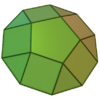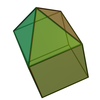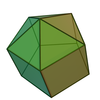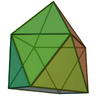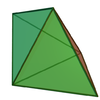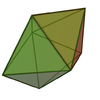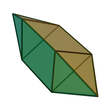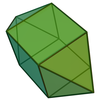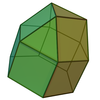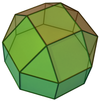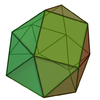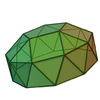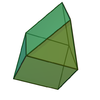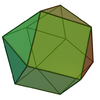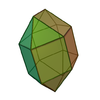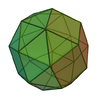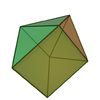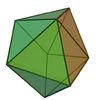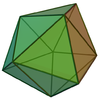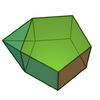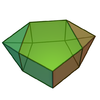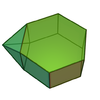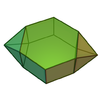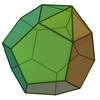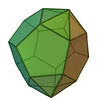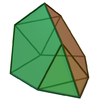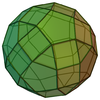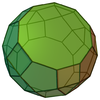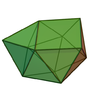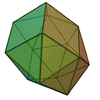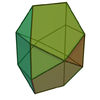List of Johnson solids
In geometry, a convex polyhedron whose faces are regular polygons is known as a Johnson solid, or sometimes as a Johnson–Zalgaller solid.[1] Some authors exclude uniform polyhedra (in which all vertices are symmetric to each other) from the definition; uniform polyhedra include Platonic and Archimedean solids as well as prisms and antiprisms.[2] The Johnson solids are named after American mathematician Norman Johnson (1930–2017), who published a list of 92 non-uniform Johnson polyhedra in 1966. His conjecture that the list was complete and no other examples existed was proven by Russian-Israeli mathematician Victor Zalgaller (1920–2020) in 1969.[3]
Some of the Johnson solids may be categorized as elementary polyhedra, meaning they cannot be separated by a plane to create two small convex polyhedra with regular faces. The Johnson solids satisfying this criteria are the first six—equilateral square pyramid, pentagonal pyramid, triangular cupola, square cupola, pentagonal cupola, and pentagonal rotunda. The criteria is also satisfied by eleven other Johnson solids, specifically the tridiminished icosahedron, parabidiminished rhombicosidodecahedron, tridiminished rhombicosidodecahedron, snub disphenoid, snub square antiprism, sphenocorona, sphenomegacorona, hebesphenomegacorona, disphenocingulum, bilunabirotunda, and triangular hebesphenorotunda.[4] The rest of the Johnson solids are not elementary, and they are constructed using the first six Johnson solids together with Platonic and Archimedean solids in various processes. Augmentation involves attaching the Johnson solids onto one or more faces of polyhedra, while elongation or gyroelongation involve joining them onto the bases of a prism or antiprism, respectively. Some others are constructed by diminishment, the removal of one of the first six solids from one or more of a polyhedron's faces.[5]
The following table contains the 92 Johnson solids, with edge length . The table includes the solid's enumeration (denoted as ).[6] It also includes the number of vertices, edges, and faces of each solid, as well as its symmetry group, surface area , and volume . Every polyhedron has its own characteristics, including symmetry and measurement. An object is said to have symmetry if there is a transformation that maps it to itself. All of those transformations may be composed in a group, alongside the group's number of elements, known as the order. In two-dimensional space, these transformations include rotating around the center of a polygon and reflecting an object around the perpendicular bisector of a polygon. A polygon that is rotated symmetrically by is denoted by , a cyclic group of order ; combining this with the reflection symmetry results in the symmetry of dihedral group of order .[7] In three-dimensional symmetry point groups, the transformations preserving a polyhedron's symmetry include the rotation around the line passing through the base center, known as the axis of symmetry, and the reflection relative to perpendicular planes passing through the bisector of a base, which is known as the pyramidal symmetry of order . The transformation that preserves a polyhedron's symmetry by reflecting it across a horizontal plane is known as the prismatic symmetry of order . The antiprismatic symmetry of order preserves the symmetry by rotating its half bottom and reflection across the horizontal plane.[8] The symmetry group of order preserves the symmetry by rotation around the axis of symmetry and reflection on the horizontal plane; the specific case preserving the symmetry by one full rotation is of order 2, often denoted as .[9] The mensuration of polyhedra includes the surface area and volume. An area is a two-dimensional measurement calculated by the product of length and width; for a polyhedron, the surface area is the sum of the areas of all of its faces.[10] A volume is a measurement of a region in three-dimensional space.[11] The volume of a polyhedron may be ascertained in different ways: either through its base and height (like for pyramids and prisms), by slicing it off into pieces and summing their individual volumes, or by finding the root of a polynomial representing the polyhedron.[12]
References
- ^ Araki, Yoshiaki; Horiyama, Takashi; Uehara, Ryuhei (2015). Rahman, M. Sohel; Tomita, Etsuji (eds.). "Common Unfolding of Regular Tetrahedron and Johnson-Zalgaller Solid". WALCOM: Algorithms and Computation. Cham: Springer International Publishing: 294–305. doi:10.1007/978-3-319-15612-5_26. ISBN 978-3-319-15612-5.
- ^
- ^
- ^
- Cromwell (1997), p. 86–87, See the figure on p.89
- Johnson (1966)
- ^
- ^ Uehara (2020), p. 62.
- ^
- Powell (2010), p. 27
- Solomon (2003), p. 40
- ^ Flusser, Suk & Zitofa (2017), p. 126.
- ^
- ^ Walsh (2014), p. 284.
- ^ Parker (1997), p. 264.
- ^
- ^ Johnson (1966).
- ^ Berman (1971).
Bibliography
- Berman, M. (1971). "Regular-faced convex polyhedra". Journal of the Franklin Institute. 291 (5): 329–352. doi:10.1016/0016-0032(71)90071-8. MR 0290245.
- Boissonnat, J. D.; Yvinec, M. (June 1989). Probing a scene of non convex polyhedra (PDF). Proceedings of the fifth annual symposium on Computational geometry. pp. 237–246. doi:10.1145/73833.73860.
- Cromwell, P. R. (1997). Polyhedra. Cambridge University Press. ISBN 978-0-521-66405-9.
- Diudea, M. V. (2018). Multi-shell Polyhedral Clusters. Springer. doi:10.1007/978-3-319-64123-2. ISBN 978-3-319-64123-2.
- Flusser, J.; Suk, T.; Zitofa, B. (2017). 2D and 3D Image Analysis by Moments. John Wiley & Sons. ISBN 978-1-119-03935-8.
- Hergert, W.; Geilhufe, M. (2018). Group Theory in Solid State Physics and Photonics: Problem Solving with Mathematica. John Wiley & Sons. ISBN 978-3-527-41300-3.
- Holme, A. (2010). Geometry: Our Cultural Heritage. Springer. doi:10.1007/978-3-642-14441-7. ISBN 978-3-642-14441-7.
- Johnson, N. (1966). "Convex Solids with Regular Faces". Canadian Journal of Mathematics. 18: 169–200. doi:10.4153/CJM-1966-021-8.
- Litchenberg, D. R. (1988). "Pyramids, Prisms, Antiprisms, and Deltahedra". The Mathematics Teacher. 81 (4): 261–265. JSTOR 27965792.
- Meyer, W. (2006). Geometry and Its Applications. Academic Press. ISBN 978-0-123-69427-0.
- Parker, S. P. (1997). Dictionary of Mathematics. McGraw Hill. ISBN 978-0-070-52433-0.
- Powell, R. C. (2010). Symmetry, Group Theory, and the Physical Properties of Crystals. Springer. doi:10.1007/978-1-4419-7598-0. ISBN 978-1-441-97598-0.
- Rajwade, A. R. (2001). Convex Polyhedra with Regularity Conditions and Hilbert's Third Problem. Texts and Readings in Mathematics. Hindustan Book Agency. doi:10.1007/978-93-86279-06-4. ISBN 978-9-386-27906-4.
- Solomon, R. (2003). Abstract Algebra. American Mathematical Society. ISBN 978-0-821-84795-4.
- Slobodan, M.; Obradović, M.; Ðukanović, G. (2015). "Composite Concave Cupolae as Geometric and Architectural Forms" (PDF). Journal for Geometry and Graphics. 19 (1): 79–91.
- Timofeenko, A. V. (2009). "The Non-Platonic and Non-Archimedean Noncomposite Polyhedra". Journal of Mathematical Sciences. 162 (5): 710–729. doi:10.1007/s10958-009-9655-0.
- Todesco, G. M. (2020). "Hyperbolic Honeycomb". In Emmer, M.; Abate, M. (eds.). Imagine Math 7: Between Culture and Mathematics. Springer. doi:10.1007/978-3-030-42653-8. ISBN 978-3-030-42653-8.
- Uehara, R. (2020). Introduction to Computational Origami: The World of New Computational Geometry. Springer. doi:10.1007/978-981-15-4470-5. ISBN 978-9-811-54470-5.
- Walsh, E. T. (2014). A First Course in Geometry. Dover. ISBN 978-0-486-78020-7.
- Williams, K.; Monteleone, C. (2021). Daniele Barbaro’s Perspective of 1568. Springer. doi:10.1007/978-3-030-76687-0. ISBN 978-3-030-76687-0.
- Zalgaller, V. A. (1969). Convex Polyhedra with Regular Faces. Springer. ISBN 978-1-489-95671-2.
External links
- Hart, George W. "Johnson Solids".
- Bulatov, Vladimir. "Johnson solids". – VRML models of Johnson solids
- Gagnon, Sylvain (1982). "Les polyèdres convexes aux faces régulières" [Convex polyhedra with regular faces] (PDF). Topologie Structurale [Structural Topology] (in French) (6): 83–95.




























